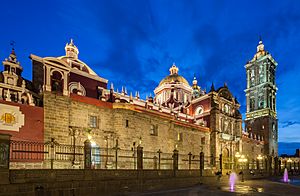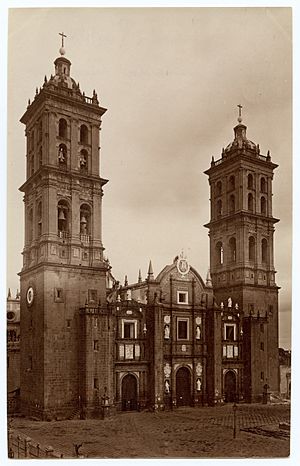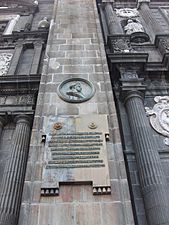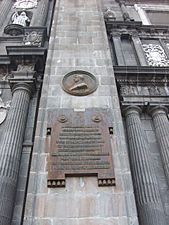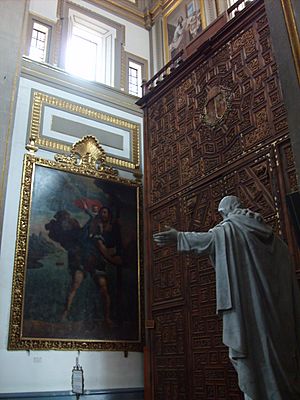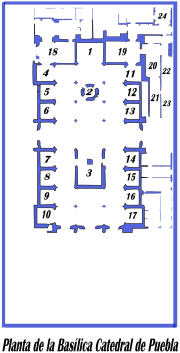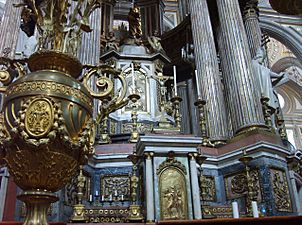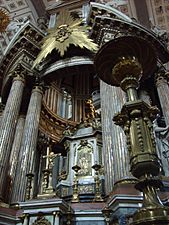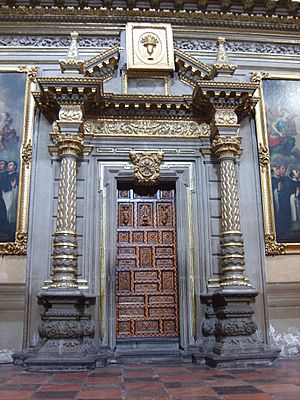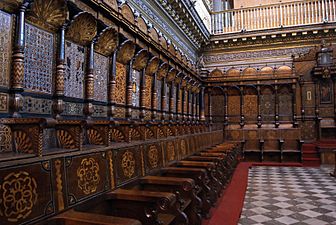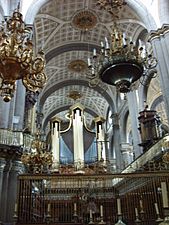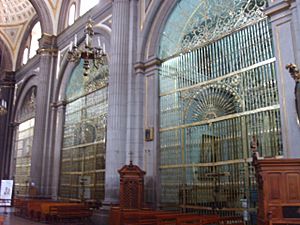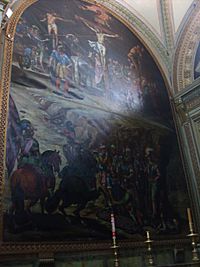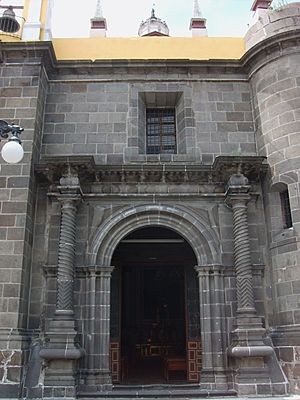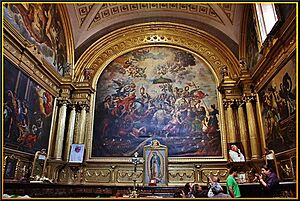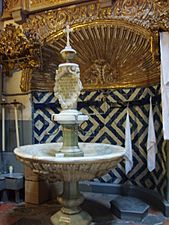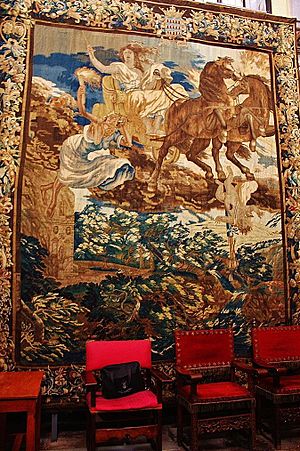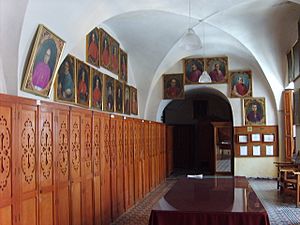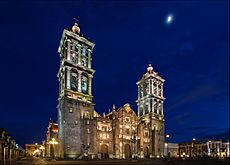Puebla Cathedral facts for kids
Quick facts for kids Cathedral Basilica of Puebla |
|
|---|---|
|
Basílica Catedral Metropolitana de Nuestra Señora de la Purísima Concepción
|
|
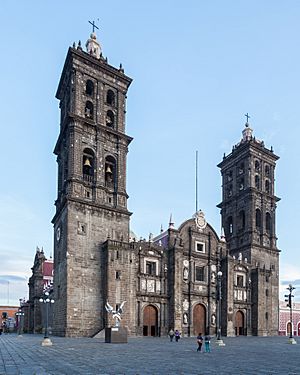
Puebla Cathedral
|
|
| Religion | |
| Affiliation | Roman Catholic |
| District | Archdiocese of Puebla de los Ángeles |
| Ecclesiastical or organizational status | Cathedral and Minor basilica |
| Year consecrated | 18 April 1649 |
| Location | |
| Location | Puebla de Zaragoza, Mexico |
| Architecture | |
| Architect(s) | Francisco Becerra and Juan Gómez de Trasmonte (cathedral) Manuel Tolsá (cypress) Pedro García Ferrer (Altar of the Kings) Cristóbal de Villalpando (frescoes) |
| Architectural style | Herrerian style (mainly), Neoclassical, Baroque |
| Groundbreaking | 18 November 1575 |
| Completed | (South tower) 1737 |
| Specifications | |
| Direction of façade | West-Orient |
| Length | 97.67 m (320 ft) |
| Width | 51 m (170 ft) |
| Width (nave) | 82 m (270 ft) |
| Spire(s) | 2 |
| Spire height | 70 m (230 ft) |
| Official name: Part of the Historic Centre of Puebla | |
| Type: | Cultural |
| Criteria: | ii, iv |
| Designated: | 1987 (11th session) |
| Reference #: | 416 |
| Region: | Latin America and the Caribbean |
The Cathedral Basilica of Puebla is a very important church in Puebla, Mexico. It's also known as the Cathedral of Our Lady of the Immaculate Conception. This building is the main church for the Archdiocese of Puebla. It's a key part of the historic center of Puebla, which is a World Heritage Site recognized by UNESCO.
This cathedral was one of the first grand churches built in the Americas. It was finished in 1649, even before the Metropolitan Cathedral of Mexico City, which was completed in 1653. Philip II of Spain started its construction.
The current cathedral was built between the 16th and 17th centuries. It replaced an older church that stood in the same spot. It took 74 years to build, from 1575 until its dedication in 1649. Work stopped for a while but started again in 1640 when Bishop Juan de Palafox y Mendoza arrived. He was very enthusiastic about finishing it. The new design made the central part of the church taller, letting in more natural light.
The cathedral is shaped like a rectangle and has five main sections inside. It's known for its beautiful Renaissance-style front. At over 70 meters tall, it was once the tallest church in the Spanish colonies.
Inside, the cathedral is like a huge museum. It holds many valuable paintings, sculptures, and gold items from the time of New Spain and later. Its sacristy (a room where priests prepare) has rich robes embroidered with gold and silver, plus sacred cups and crosses decorated with jewels. The church also has old documents that go back to when the city was founded.
Contents
- How the Cathedral Was Started
- Outside the Cathedral
- Inside the Cathedral
- Altars of the Gospel and the Epistle
- Cathedral Layout
- Altar of the Kings
- High Altar (Cypress)
- The Choir
- Chapels on the Gospel Side
- Chapels on the Epistle Side
- The Sagrario (Sanctuary)
- The Sacristy
- Hall of the Gobelins
- Chapter House
- Chocolatier Hall
- The Cathedral Archive
- Chapel of the Holy Spirit (Ochavo)
- Cathedral Jewelry
- Mass Schedules
- See also
How the Cathedral Was Started
The First Church Building
In 1531, Queen Isabella of Portugal allowed a Spanish town to be built in the area of Cuetlaxcoapan. The first church was needed for this new town. It was built in front of the main square. In 1535, people decided to build a new, bigger church. Bishop Julián Garcés also wanted a new temple.
The Old Main Church
By 1537, Bishop Garcés moved to the new city. In 1543, King Carlos V, Holy Roman Emperor approved building a new main church for the bishop. The land for the church was next to the main square. Construction began on August 29, 1535.
The church built in 1535 was on the same spot as today's cathedral. It faced north, towards the main square. People at the time said it was "very solemn, and stronger and larger than all those built to date." It had three main sections and strong black stone pillars. However, it needed repairs often. The people of Puebla wanted an even grander church, and eventually, the king agreed to a new cathedral.
Building the New Cathedral
It took many years to get the plans ready for the new cathedral. Finally, on November 18, 1575, construction began. The first architect was Francisco Becerra from Spain. He created the design and model. Workers from nearby towns like Cholula and Tlaxcala helped build it.
The cathedral was planned to be in the middle of a large block, with a courtyard in front. The main entrance would face west, and the main square would be on its north side.
In 1580, Francisco Becerra left to work on other cathedrals. The work on Puebla's cathedral stopped and started again several times. By 1618, only the walls were built. The altars, chapels, and roof were still missing. In 1634, Juan Gómez de Trasmonte started to update Becerra's design. But it wasn't until Bishop Juan de Palafox y Mendoza arrived in 1640 that the project truly moved forward.
Gómez de Trasmonte, who had also worked on the Mexico City Metropolitan Cathedral, changed the design to be more classical.
The Time of Bishop Palafox y Mendoza
Bishop Palafox arrived in Puebla with an order from the king to finish the cathedral. He found the church in bad shape, with only half the pillars built and no materials ready. He said, "I found this temple built only up to half of the pillars and everything exposed... Outlaws of justice were collected in it... Married Indians lived in the chapels."
Palafox started a big fundraising effort. He used his own money and asked for contributions from everyone in Puebla. He also raised church taxes, which caused some disagreements with other religious groups.
About 1,500 workers helped build the cathedral under Palafox's supervision. Gómez de Trasmonte's design made the central part of the church taller for better light. The cathedral was officially dedicated on April 18, 1649, even though the towers and front were not fully finished.
A few days after the dedication, the remains of five bishops were moved to the cathedral. The city celebrated, but also felt sad because Bishop Palafox was leaving for Spain. He had helped build not only the cathedral but also colleges and the famous Palafoxian Library.
Later Additions to the Cathedral
- The main entrance, called the Puerta del Perdón (Door of Forgiveness), was finished in 1664.
- In 1664, the "Ochavo" was approved. This was a special room to store valuable religious items. Architect Carlos García Durango oversaw its construction.
- The side entrance facing north, called San Cristóbal, was completed in 1690.
- Iron railings and gates were added around 1691.
- In 1772, the entire cathedral floor was paved with beautiful Santo Tomás marble. This replaced the original brick floor.
Outside the Cathedral
The cathedral building is 97.67 meters long and 51 meters wide. It faces east to west, with the main altar on the east side and the main entrance on the west. The main square is on its north side.
Cathedral Towers
The north tower, which holds the bells, was finished in 1678. It's also called the Old Tower. The south tower was built later, in 1731, and opened in 1768. Both towers are 70 meters tall. At the time, they were the tallest in the American colonies.
The two towers look alike. They have several levels with arches for bells. The top of the towers has domes made of brick and colorful azulejo tiles. A white stone globe and a cross sit on top of each dome.
The Bells
The Old Tower has ten bells. The heaviest and most famous bell is called "Campana María" (Mary Bell). It weighs over 8 tons! There's a famous legend that angels lifted this huge bell into place. But in reality, it was raised in 1732 by a skilled worker named Juan Bautista Santiago.
- Memorable Bell Ringings
The cathedral bells have rung for many special events throughout history:
- On August 2, 1821, when the Army of the Three Guarantees entered the city.
- On May 5, 1862, after the French army was defeated in the Battle of Puebla. People celebrated all night!
- On May 5, 1962, to mark 100 years since the Battle of Loreto y Guadalupe.
- On January 28, 1979, when Pope John Paul II visited Puebla.
Cathedral Entrances
The cathedral has five entrances, all in a simple Renaissance style.
The Main Entrance and Sides
The main entrance is called the "Puerta del Perdón" (Door of Forgiveness). It's 34 meters tall and only opens for very special occasions. It was finished in 1664. This entrance has three levels with statues of saints like Saint Peter and Saint Paul. It also features shields with the symbol of the Immaculate Conception.
On either side of the main entrance, there are two plaques with Latin writings. One remembers the first bishop, Julián Garcés, and the other the first Archbishop, Ramón Ibarra y González.
The side entrances have beautiful stone carvings. One shows Saint Rose of Lima receiving roses from the Virgin. The other shows Saint Teresa of Ávila in a moment of religious ecstasy.
-
Religious ecstasy of Saint Teresa of Ávila
North and South Side Entrances
The entrance facing the main square is called San Cristóbal, named after Saint Christopher. A huge wooden statue of this saint used to stand behind the door. Today, a large painting of Saint Christopher is there.
The North and South entrances are similar. The South one is simpler, without statues. It was reopened to the public in September 2010 after being closed for over 50 years. The North entrance is about 30 meters tall and has three levels with columns and statues of saints like Saint John the Evangelist and Saint Matthew.
Domes: Main and Kings' Chapel
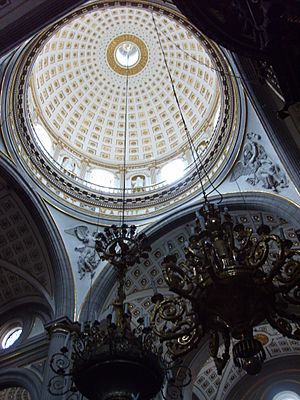
The main dome is shaped like half an orange and sits above the center of the church. It's 43 meters high. Inside, it has sculptures of evangelists and prophets. The outside is covered with yellow and green azulejo tiles.
The dome of the Chapel of the Kings is smaller. It has four windows and looks very bright when the church is lit up at night.
The Atrium (Courtyard)
The area in front of the cathedral, called the atrium, was once home to the older church. Over time, it became a large open space. In the 18th century, the atrium was paved and surrounded by columns and statues of saints.
The current metal fence around the atrium was built starting in 1878. It was paid for by private donors.
Inside the Cathedral
The inside of the cathedral is 97.67 meters long and 51 meters wide. It has five main sections: a central nave, two side naves, and two rows of chapels.
There are 14 huge columns, almost 15 meters tall, that support the roof and arches. All the stone used was brought from nearby towns and carved very precisely. In total, there are 74 columns and six pillars supporting 40 vaults and two domes.
The main dome is made of light pumice stone. The other domes are made of lime and stone. Eight niches in the main dome have white stucco sculptures of prophets and evangelists, created by Pedro García Ferrer.
The floor is made of red and black marble. The cathedral is lit by 124 windows, which originally had 2,215 glass panes installed in 1664.
Altars of the Gospel and the Epistle
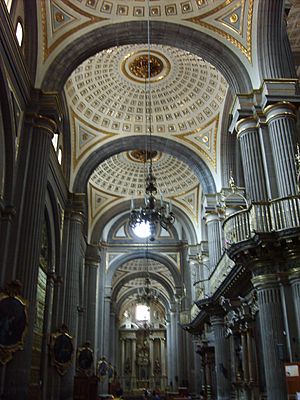
Each side nave has an altar at its end. The one on the left (Gospel side) is for Saint Joseph, and the one on the right (Epistle side) is for Archangel Michael. Both altars are gilded and have beautiful silver decorations. The Archangel Michael altar has statues of Archangel Gabriel and Archangel Raphael. The Saint Joseph altar has statues of Joachim and Saint Anne.
- Stations of the Cross
Along both side naves, there are paintings showing the Stations of the Cross. These were created by the famous 18th-century painter Miguel Cabrera.
- Transept
In the north part of the transept (the cross-shaped part of the church), there's a large painting of Saint Christopher carrying the Child Jesus. On the south side, there are paintings representing Saint Joseph and scenes from the life of Saint John Nepomucene.
Cathedral Layout
- Altar of the Catholic Monarchs.
- High altar or baldachin (Cypress).
- Choir and organs.
- Chapel del Apóstol Santiago.
- Chapel of San Pedro.
- Chapel of Our Lady of Guadalupe.
- Chapel del Sagrado Corazón de María.
- Chapel of la Inmaculada Concepción.
- Chapel del Señor de la Preciosa Sangre.
- Chapel of San Nicolás De Bari.
- Chapel of Nuestra Señora de los Dolores.
- Chapel del Sagrado Corazón de Jesús.
- Chapel of las Santas Reliquias.
- Chapel of San Juan Nepomuceno.
- Chapel del Señor de la Columna.
- Chapel of la Virgen de Ocotlán.
- Chapel of Nuestra Señora de la Soledad.
- Tabernacle.
- Sacristy.
- Hall of los Gobelinos.
- Chapter House
- Hall of the Cathedral Chapter
- Archive.
- Chapel del Espíritu Santo (Ochavo).
Altar of the Kings

This altar is named for the statues of holy kings and queens on its sides. It includes a dome, a main altarpiece, and a tabernacle. The main altarpiece was designed by Juan Martínez Montañés and built by Lucas Méndez. It was dedicated in 1649.
The beautiful painting on the dome is one of the few tempera paintings left in Mexico. It shows the triumph of the Eucharist and was painted by Cristóbal de Villalpando in 1688. He also painted the four Jewish heroines: Judith, Ruth, Esther, and Jael.
The altar also features paintings like the Coronation of the Virgin Mary and the Assumption of Mary. Statues of saints like Edward the Confessor, Ferdinand III of Castile, Helena of Constantinople, and Margaret Queen of Scotland are also present. All the paintings on this altar, except the dome, were made by Pedro García Ferrer.
High Altar (Cypress)

The main altar, called the Cypress, was built between 1799 and 1819. It was designed by Manuel Tolsá, a famous architect. The construction was a huge project that took 20 years. It was blessed on December 5, 1819. The remains of many bishops are buried in crypts beneath this altar.
- Architecture
The Cypress is 17.50 meters tall. It's built in a Neoclassical style, using different materials like Tecali marble, stucco, bronze, and cedar wood.
The Cypress has a circular base with 16 columns. These columns surround statues of important church figures like Saint Gregory and Saint Augustine. The most important part is the bronze statue of the Immaculate Conception, which weighs 920 kilograms. The base of the Cypress has four small doors that lead to the bishops' crypts. These are only opened on November 2, All Souls' Day.
The Choir
The Choir is located in front of the main entrance. It was built in the late 17th and early 18th centuries for the church council to hold their prayers.
The Choir is shaped like a horseshoe and is closed off by a beautiful iron gate from the 17th century. Inside, there are 52 chairs for the church leaders, made of fine wood with bone and ivory designs. In the center, there's a cedar lectern holding old books with Gregorian music.
- Organs
The cathedral has three organs. The oldest one, built between 1710 and 1719, is no longer used. Another old organ was built in 1737. The largest organ is called the "International" organ. It was built with parts from the United States (electronic parts), Germany (pipes), and Mexico (wood assembly and decoration). It has 3376 pipes and is used for special events like weddings and concerts. It was first played on December 8, 1973. The two older organs are kept as historical decorations.
Chapels on the Gospel Side
The left side of the cathedral has several chapels:
- Chapel of Saint James the Apostle
This chapel was originally for Saint James the Great. It has a sculpture of Saint James the Less and paintings by Rafael Morante. The remains of General José María Calderón, Puebla's first governor, are buried here.
- Chapel of Saint Peter
This chapel has an altarpiece from 1830 with sculptures of Saint Peter and Saint Paul. It also features paintings by Vincenzo Camuccini.
- Chapel of Our Lady of Guadalupe
This chapel features a famous painting of The Virgin of Guadalupe by Miguel Cabrera. It also has paintings by Cristóbal de Villalpando. The remains of Ramón Ibarra y González, Puebla's first Archbishop, are buried on the floor here.
- Chapel of the Sacred Heart of Mary
This chapel was redecorated by José Manzo in the Neoclassical style. It has a painting called "Mary health of the sick" by Francisco Morales Van den Eyden. People often call it the "Sweet Heart of Mary" chapel.
- Chapel of the Immaculate Conception
This chapel was managed by Puebla's silversmiths. It has a statue of the Immaculate Conception and paintings of Friar John Scotus Eriugena and Pope Pius IX.
- Chapel of the Precious Blood of Christ
This chapel has a life-size sculpture of the crucified Jesus. It's believed to be made from corn cane paste, a material from Michoacán. The chapel also has sculptures of the Virgin of Hope and Saint John the Baptist.
- Chapel of Saint Nicholas of Bari
This chapel was once a baptistery. In the early 20th century, the worship of Saint Nicholas of Bari was moved here. The chapel has a sculpture of Saint Nicholas and paintings about the Virgin Mary's family.
Chapels on the Epistle Side
The right side of the cathedral has these chapels:
- Chapel of Our Lady of Sorrows
This chapel connects to the sacristy. It has a representation of the Virgin of Sorrows and the Calvary.
- Chapel of the Sacred Heart of Jesus
This chapel has a painting of Our Lady of La Manga. The remains of General Miguel Miramón and journalist Trinidad Sánchez Santos are also here.
- Chapel of the Holy Relics
This chapel was dedicated to different saints over time. In the late 17th century, it became the place for relics (holy objects). José Manzo redecorated it. It contains busts with bone fragments of saints and paintings by Juan Tinoco.
-
Religious ecstasy of Saint Teresa of Ávila
- Chapel of Saint John Nepomucene
This chapel was originally for Saint John the Evangelist. Later, it was dedicated to Saint Nicholas of Bari, but his worship was moved due to crowds. Now it's for Saint John of Nepomuk. It has a painting of the Virgin of la Luz and sculptures by José Antonio Villegas Cora.
- Chapel of the Lord of the Column
This chapel has a statue of the Lord of the Whips from Acatzingo. The side walls have two large paintings by Cristóbal de Villalpando from 1683: The descent from the Cross and the Transfiguration of Jesus.
- Chapel of the Holy Shroud
José Manzo also redecorated this chapel. It has a neo-Gothic bronze canopy that holds a replica of the Virgin of Ocotlán. Many people call this chapel by her name.
Every Good Friday, the canopy is opened to show a copy of the Holy Shroud. This copy is very old, dating back to 1594. It was brought to Mexico by Archdeacon Fernando Gutiérrez Pacheco.
- Chapel of Our Lady of Solitude
This chapel has a Neoclassical altarpiece. The side walls have two 17th-century paintings about the Passion, The Descent and The Calvary.
The Sagrario (Sanctuary)
The Capilla del Sagrario Metropolitano is a separate chapel within the cathedral. It was created to handle sacraments and spiritual services for the Spanish population, so the main cathedral could focus on its role as the bishop's seat.
The Sacristy
The sacristy is a large room, 17 meters long and 10.40 meters wide. It has large wooden drawers for storing rich church robes. The walls are covered with many paintings. The main painting shows The Triumph of the Catholic Church over paganism by Baltasar de Echave Rioja. Other paintings show scenes from the Apocalypse.
Another painting shows the Immaculate Conception with bishops like Julián Garcés and Juan de Palafox y Mendoza. There's also a painting called The lavatory by Luis Berrueco. In one corner, there's a 3-meter-high marble fountain.
Hall of the Gobelins
This room displays four magnificent tapestries, also known as gobelins. They show scenes from Greek mythology, like Queen Hippolyta and the meeting of Thalestris and Alexander the Great. These tapestries were made in France by Jean Gobelin in the 15th century and brought by the Spanish.
Chapter House
This room, also called the Hall of Bishops, is where the portraits of all the bishops of Puebla are displayed. In the center, there's a statue of Saint John Nepomuk, reminding everyone about the secrecy of the meetings held here. It's a less known part of the cathedral, usually only accessed by a few people.
Chocolatier Hall
The Chocolatier Hall is next to the Hall of the Gobelins. It was used by church officials to store their belongings and to have breakfast or snacks during long meetings. Cups of chocolate were always served here. The walls have oil portraits of important church leaders who later became bishops.
The Cathedral Archive
The Cathedral Chapter has a very important archive, though it's quite small. It holds documents dating back to 1539, even before archives were required for cathedrals in New Spain. These documents include records of council meetings, royal orders, and information about church buildings.
Over the years, some documents were lost or stolen. For example, there are no original signatures of Bishop Palafox because older students were sometimes given them as souvenirs. Despite this, the archive is still considered one of the most important for understanding the history of the region.
Music in the Archive
The Puebla cathedral has a rich history of music. One of its most famous musicians was Juan Gutiérrez de Padilla, who was the chapel master from 1629 to 1664. He wrote complex music, including pieces for multiple choirs and Christmas songs called villancicos. His music even shows influences from different cultures in New Spain, like the Nahua and African people. The archive still has his original music books. His villancicos are considered a major contribution to American music history.
Chapel of the Holy Spirit (Ochavo)
This chapel is better known as the Ochavo. It has an 8-sided dome and is decorated with small paintings and mirrors. It's in the Baroque style from the 17th century. The paintings are by Cristóbal de Villalpando. It was built under Bishop Manuel Fernández de Santa Cruz by architect Carlos García Durango in 1674.
Cathedral Jewelry
The cathedral has many valuable items. The Cypress altar is decorated with 48 silver and gold candlesticks. There are also beautiful silver jugs and 25 oil lamps hanging from the ceiling. Two large lamps, over 2 meters tall, hang on either side of the tabernacle.
One special lamp, made of silver and gold, was created by goldsmith Diego Larios in 1751. It has 42 lights. The cathedral also has other sets of candlesticks, scepters, and gold thuribles (incense burners).
The monstrance (a vessel for displaying the Eucharist) used on special days is made of gold and decorated with many diamonds and emeralds. It was first used in 1727. Another gold monstrance, decorated with pearls, emeralds, and diamonds, was made by Antonio de Villafañe in 1803.
A writer named Francisco Javier Clavijero described some of these treasures, saying the cathedral's silverware was "superb." He mentioned a large silver lamp and a solid gold monstrance with precious stones, including a diamond worth a lot of money.
The cathedral also has two gold sacred vessels and a beautiful 5.5-meter-tall ebony wood structure called a tenebrio, decorated with silver.
Mass Schedules
The cathedral basilica holds five daily masses from Monday to Saturday. On Sundays, there are many more, with up to ten masses celebrated. The times can change for holidays like Easter or Christmas.
| Mass schedule |
|---|
| Sundays |
| 7 a.m., 8 a.m., 9 a.m., 10 a.m., 11 a.m., 12 p.m., 1 p.m., 6 p.m., 7 p.m. and 8 p.m. |
| Monday to Saturday |
| 7 a.m., 8 a.m., 9 a.m., 9.45 a.m., and 7 p.m. (On Mondays, at 12:00 p.m., the mass is celebrated in honor of Saint Nicholas of Bari.) |
See also
 In Spanish: Catedral metropolitana de Puebla para niños
In Spanish: Catedral metropolitana de Puebla para niños
- List of buildings in Puebla City
- Atrial cross


